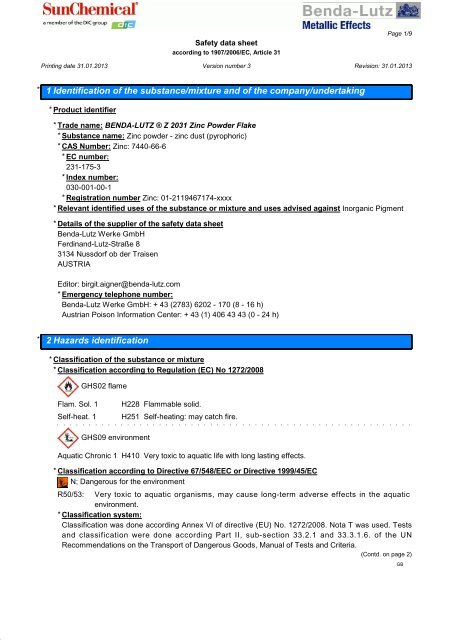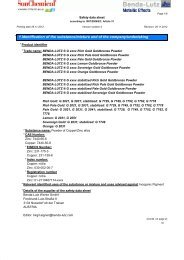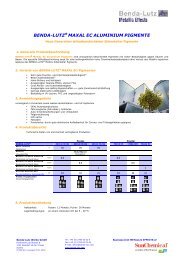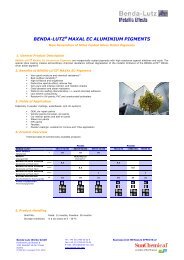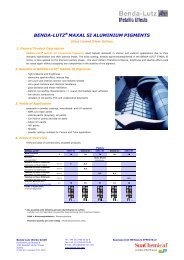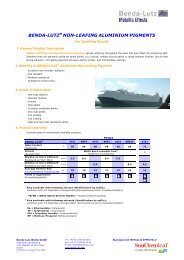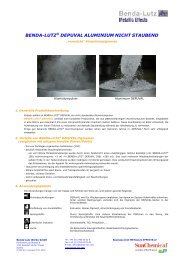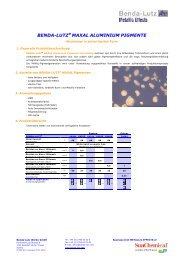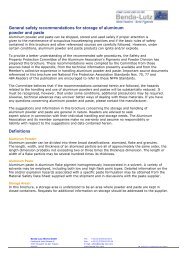1 Identification of the substance/mixture and of the company ...
1 Identification of the substance/mixture and of the company ...
1 Identification of the substance/mixture and of the company ...
You also want an ePaper? Increase the reach of your titles
YUMPU automatically turns print PDFs into web optimized ePapers that Google loves.
36.0<br />
Safety data sheet<br />
according to 1907/2006/EC, Article 31<br />
Page 1/9<br />
Printing date 31.01.2013 Version number 3<br />
Revision: 31.01.2013<br />
* 1 <strong>Identification</strong> <strong>of</strong> <strong>the</strong> <strong>substance</strong>/<strong>mixture</strong> <strong>and</strong> <strong>of</strong> <strong>the</strong> <strong>company</strong>/undertaking<br />
* Product identifier<br />
* Trade name: BENDA-LUTZ ® Z 2031 Zinc Powder Flake<br />
* Substance name: Zinc powder - zinc dust (pyrophoric)<br />
* CAS Number: Zinc: 7440-66-6<br />
* EC number:<br />
231-175-3<br />
* Index number:<br />
030-001-00-1<br />
* Registration number Zinc: 01-2119467174-xxxx<br />
* Relevant identified uses <strong>of</strong> <strong>the</strong> <strong>substance</strong> or <strong>mixture</strong> <strong>and</strong> uses advised against Inorganic Pigment<br />
* Details <strong>of</strong> <strong>the</strong> supplier <strong>of</strong> <strong>the</strong> safety data sheet<br />
Benda-Lutz Werke GmbH<br />
Ferdin<strong>and</strong>-Lutz-Straße 8<br />
3134 Nussdorf ob der Traisen<br />
AUSTRIA<br />
Editor: birgit.aigner@benda-lutz.com<br />
* Emergency telephone number:<br />
Benda-Lutz Werke GmbH: + 43 (2783) 6202 - 170 (8 - 16 h)<br />
Austrian Poison Information Center: + 43 (1) 406 43 43 (0 - 24 h)<br />
* 2 Hazards identification<br />
* Classification <strong>of</strong> <strong>the</strong> <strong>substance</strong> or <strong>mixture</strong><br />
* Classification according to Regulation (EC) No 1272/2008<br />
GHS02 flame<br />
Flam. Sol. 1<br />
Self-heat. 1<br />
H228 Flammable solid.<br />
H251 Self-heating: may catch fire.<br />
GHS09 environment<br />
Aquatic Chronic 1 H410 Very toxic to aquatic life with long lasting effects.<br />
* Classification according to Directive 67/548/EEC or Directive 1999/45/EC<br />
N; Dangerous for <strong>the</strong> environment<br />
R50/53: Very toxic to aquatic organisms, may cause long-term adverse effects in <strong>the</strong> aquatic<br />
environment.<br />
* Classification system:<br />
Classification was done according Annex VI <strong>of</strong> directive (EU) No. 1272/2008. Nota T was used. Tests<br />
<strong>and</strong> classification were done according Part II, sub-section 33.2.1 <strong>and</strong> 33.3.1.6. <strong>of</strong> <strong>the</strong> UN<br />
Recommendations on <strong>the</strong> Transport <strong>of</strong> Dangerous Goods, Manual <strong>of</strong> Tests <strong>and</strong> Criteria.<br />
(Contd. on page 2)<br />
GB
36.0<br />
Safety data sheet<br />
according to 1907/2006/EC, Article 31<br />
Page 2/9<br />
Printing date 31.01.2013 Version number 3<br />
Revision: 31.01.2013<br />
* Label elements<br />
* Labelling according to Regulation (EC) No 1272/2008<br />
The <strong>substance</strong> is classified <strong>and</strong> labelled according to <strong>the</strong> CLP regulation.<br />
* Hazard pictograms<br />
(Contd. <strong>of</strong> page 1)<br />
GHS02 GHS09<br />
* Signal word Danger<br />
* Hazard statements<br />
H228 Flammable solid.<br />
H251 Self-heating: may catch fire.<br />
H410 Very toxic to aquatic life with long lasting effects.<br />
* Precautionary statements<br />
P210 Keep away from heat/sparks/open flames/hot surfaces. - No smoking.<br />
P241 Use explosion-pro<strong>of</strong> electrical/ventilating/lighting/equipment.<br />
P273 Avoid release to <strong>the</strong> environment.<br />
P370+P378 In case <strong>of</strong> fire: Use for extinction: Special powder for metal fires.<br />
P370+P378 In case <strong>of</strong> fire: Use for extinction: S<strong>and</strong>.<br />
* Information concerning particular hazards for human <strong>and</strong> environment:<br />
The product is irritating on mucous membrane contact.<br />
In case <strong>of</strong> inhalation <strong>of</strong> big dust quantities <strong>of</strong> <strong>the</strong> product urgent symptoms <strong>of</strong> influenza ("Zinc fever") are<br />
possible.<br />
Very toxic to aquatic organisms, may cause long-term adverse effects in <strong>the</strong> aquatic environment.<br />
* O<strong>the</strong>r hazards<br />
The product is combustible.<br />
If suspended in air, dust clouds can be ignited in <strong>the</strong> presence <strong>of</strong> an ignition source. Explosion risk!<br />
The product reacts slowly with water <strong>and</strong> violently with alkalis acids, chlorinated hydrocarbons <strong>and</strong><br />
oxidising agents what leads to generation <strong>of</strong> extremely flammable hydrogen. - Explosion risk!<br />
The product reacts with suphur under heat development - Explosion risk!<br />
* Results <strong>of</strong> PBT <strong>and</strong> vPvB assessment<br />
* PBT: Not applicable.<br />
* vPvB: Not applicable.<br />
* 3 Composition/information on ingredients<br />
* Chemical characterization: Substances<br />
* CAS No. Description<br />
Zinc<br />
* EC number: 231-175-3<br />
* Index number: 030-001-00-1<br />
* Additional information: Zinc powder, flake<br />
* SVHC No Substance <strong>of</strong> very high concern contained.<br />
4 First aid measures<br />
* Description <strong>of</strong> first aid measures<br />
* General information:<br />
At "Zinc fever" call a physician.<br />
(Contd. on page 3)<br />
GB
36.0<br />
Safety data sheet<br />
according to 1907/2006/EC, Article 31<br />
Page 3/9<br />
Printing date 31.01.2013 Version number 3<br />
Revision: 31.01.2013<br />
(Contd. <strong>of</strong> page 2)<br />
Medical attention/control after first aid measures.<br />
* After inhalation:<br />
Remove exposed person out <strong>of</strong> hazardous area.<br />
Supply fresh air.<br />
Keep breathing passages open.<br />
Call a physician if irritation persists.<br />
* After skin contact:<br />
Remove dirty clo<strong>the</strong>s.<br />
Immediately wash with water <strong>and</strong> soap <strong>and</strong> rinse thoroughly.<br />
* After eye contact: Rinse opened eye for several minutes under running water. Then consult a doctor.<br />
* After swallowing: If symptoms persist consult doctor.<br />
* Information for doctor:<br />
* Most important symptoms <strong>and</strong> effects, both acute <strong>and</strong> delayed<br />
Coughing<br />
Symptoms <strong>of</strong> influenza ("Zinc fever")<br />
* Indication <strong>of</strong> any immediate medical attention <strong>and</strong> special treatment needed<br />
Medical supervision for at least 48 hours.<br />
On ingestion or inhalation <strong>of</strong> big quantities contact toxicologist.<br />
5 Firefighting measures<br />
* Extinguishing media<br />
* Suitable extinguishing agents:<br />
Dry s<strong>and</strong><br />
Extinguishing powder for metal fire.<br />
Extinguishing media <strong>of</strong> class D.<br />
Do not use water.<br />
* For safety reasons unsuitable extinguishing agents:<br />
Water <strong>and</strong> water based extinguishers<br />
Carbon dioxide<br />
Foam<br />
Extinguishing media <strong>of</strong> class A, B, C.<br />
* Special hazards arising from <strong>the</strong> <strong>substance</strong> or <strong>mixture</strong><br />
Prolonged contact <strong>of</strong> <strong>the</strong> product with water may result in a reaction releasing hydrogen - ignition risk<br />
Dust explosion risk because <strong>of</strong> suspended dry product in <strong>the</strong> air!<br />
* Advice for firefighters<br />
* Protective equipment:<br />
Wear self-contained respiratory protective device.<br />
Equipment must meat <strong>the</strong> criteria <strong>of</strong> EN 469 at least.<br />
6 Accidental release measures<br />
* Personal precautions, protective equipment <strong>and</strong> emergency procedures<br />
Keep away from ignition sources.<br />
Avoid building <strong>of</strong> dust.<br />
Wear protective equipment. Keep unprotected persons away.<br />
* Environmental precautions:<br />
Do not allow to enter sewers/ surface or ground water.<br />
Dispose contaminated material as waste (see point 13).<br />
(Contd. on page 4)<br />
GB
36.0<br />
Safety data sheet<br />
according to 1907/2006/EC, Article 31<br />
Page 4/9<br />
Printing date 31.01.2013 Version number 3<br />
Revision: 31.01.2013<br />
* Methods <strong>and</strong> material for containment <strong>and</strong> cleaning up:<br />
Do not use a vacuum cleaner.<br />
Collect mechanically using non sparking equipment. Prevent <strong>of</strong> dust formation.<br />
Do not flush with water or aqueous cleansing agents<br />
* Reference to o<strong>the</strong>r sections<br />
See Section 1 for information on emergency telephone number.<br />
See Section 4 for information on first aid measures.<br />
See Section 5 for information on firefighting measures.<br />
See Section 7 for information on safe h<strong>and</strong>ling.<br />
See Section 8 for information on personal protection equipment.<br />
See Section 13 for disposal information.<br />
(Contd. <strong>of</strong> page 3)<br />
7 H<strong>and</strong>ling <strong>and</strong> storage<br />
* H<strong>and</strong>ling:<br />
* Precautions for safe h<strong>and</strong>ling<br />
Prevent formation <strong>of</strong> dust.<br />
Close containers carefully after use.<br />
Equipment <strong>and</strong> furniture must not be able to load statically (e.g. use full metal showels).<br />
Use respiratory equipment.<br />
* Information about fire - <strong>and</strong> explosion protection:<br />
Keep ignition sources away. - Do not smoke.<br />
Protect against electrostatic charges.<br />
Use explosion-pro<strong>of</strong> apparatus / fittings <strong>and</strong> spark-pro<strong>of</strong> tools.<br />
* Conditions for safe storage, including any incompatibilities<br />
* Storage:<br />
* Requirements to be met by storerooms <strong>and</strong> receptacles:<br />
Store in a cool <strong>and</strong> dry place.<br />
Store in non-combustible containers.<br />
Keep container tightly closed.<br />
Avoid direct sun light.<br />
* Information about storage in one common storage facility:<br />
Store away from oxidizing agents.<br />
Store away from flammable <strong>substance</strong>s.<br />
Store away from water.<br />
Protect from moisture.<br />
Do not store toge<strong>the</strong>r with acids <strong>and</strong> alkalis<br />
Do not store toge<strong>the</strong>r with chlorinated hydrocarbons.<br />
Store away from sulphur.<br />
* Fur<strong>the</strong>r information about storage conditions: None.<br />
* Specific end use(s) No fur<strong>the</strong>r relevant information available.<br />
8 Exposure controls/personal protection<br />
* Additional information about design <strong>of</strong> technical facilities: No fur<strong>the</strong>r data; see item 7.<br />
* Control parameters<br />
* Ingredients with limit values that require monitoring at <strong>the</strong> workplace: Not required.<br />
* Additional information: The lists valid during <strong>the</strong> making were used as basis.<br />
(Contd. on page 5)<br />
GB
36.0<br />
Safety data sheet<br />
according to 1907/2006/EC, Article 31<br />
Page 5/9<br />
Printing date 31.01.2013 Version number 3<br />
Revision: 31.01.2013<br />
(Contd. <strong>of</strong> page 4)<br />
* Exposure controls<br />
* Personal protective equipment:<br />
* General protective <strong>and</strong> hygienic measures:<br />
Remove <strong>and</strong> clean contaminated clo<strong>the</strong>s.<br />
Be sure to clean skin thoroughly after work <strong>and</strong> before breaks.<br />
Wash with water <strong>and</strong> soap.<br />
* Respiratory protection: Filter P1<br />
* Protection <strong>of</strong> h<strong>and</strong>s:<br />
The glove material has to be impermeable <strong>and</strong> resistant to <strong>the</strong> product/ <strong>the</strong> <strong>substance</strong>/ <strong>the</strong> preparation.<br />
Selection <strong>of</strong> <strong>the</strong> glove material on consideration <strong>of</strong> <strong>the</strong> penetration times, rates <strong>of</strong> diffusion <strong>and</strong> <strong>the</strong><br />
degradation<br />
* Material <strong>of</strong> gloves<br />
Lea<strong>the</strong>r gloves<br />
The selection <strong>of</strong> <strong>the</strong> suitable gloves does not only depend on <strong>the</strong> material, but also on fur<strong>the</strong>r marks <strong>of</strong><br />
quality <strong>and</strong> varies from manufacturer to manufacturer.<br />
* Penetration time <strong>of</strong> glove material<br />
The exact break through time has to be found out by <strong>the</strong> manufacturer <strong>of</strong> <strong>the</strong> protective gloves <strong>and</strong> has<br />
to be observed.<br />
* Eye protection:<br />
Tightly sealed goggles<br />
* Body protection:<br />
None conductive protecting clo<strong>the</strong>s<br />
Fire pro<strong>of</strong> protecting clo<strong>the</strong>s.<br />
None conductive boot according EN 345<br />
* Limitation <strong>and</strong> supervision <strong>of</strong> exposure into <strong>the</strong> environment<br />
Consider environmental precautions <strong>of</strong> point 6.<br />
* Risk management measures<br />
Skin protection cream.<br />
IN GENERAL: no pure syn<strong>the</strong>tic fabric (electrostatic charge)<br />
* 9 Physical <strong>and</strong> chemical properties<br />
* Information on basic physical <strong>and</strong> chemical properties<br />
* General Information<br />
* Appearance:<br />
* Form: Powder<br />
* Colour: black, grey<br />
* Odour: Odourless<br />
* Odour threshold: Not determined.<br />
* pH-value: Not applicable.<br />
* Change in condition<br />
* Melting point/Melting range: 420 °C<br />
* Boiling point/Boiling range: 908 °C<br />
* Flash point: Not applicable.<br />
(Contd. on page 6)<br />
GB
36.0<br />
Safety data sheet<br />
according to 1907/2006/EC, Article 31<br />
Page 6/9<br />
Printing date 31.01.2013 Version number 3<br />
Revision: 31.01.2013<br />
* Flammability (solid, gaseous): < 10 minutes (Ann. VI <strong>of</strong> Directive 1272/2008)<br />
* Self-igniting: The product is self-igniting.<br />
(Contd. <strong>of</strong> page 5)<br />
* Danger <strong>of</strong> explosion: The product is not hazardous with regard to explosions, however, it may<br />
form an explosive dust/air <strong>mixture</strong>.<br />
* Explosion limits:<br />
* Lower: 125 g/m³<br />
* Density at 20 °C: 7.14 g/cm³<br />
* Solubility in / Miscibility with<br />
* water: Insoluble.<br />
* O<strong>the</strong>r information Settled apparent density: 1,92 g/cm³ (typical value)<br />
10 Stability <strong>and</strong> reactivity<br />
* Reactivity<br />
Explosion risk when reacting with:<br />
- water, may liberate extremely flammable hydrogen gas<br />
Violent reactions with:<br />
- Acids, alkalis, oxidising agents, chlorinated hydrocarbons releasing hydrogen gas.<br />
Exo<strong>the</strong>rmic reaction with:<br />
- sulphur - Explosion risk.<br />
* Chemical stability No instability under regular conditions.<br />
* Thermal decomposition / conditions to be avoided:<br />
No decomposition if used according to specifications.<br />
* Possibility <strong>of</strong> hazardous reactions<br />
A reaction with water, acids, alkalis, oxidising agents <strong>and</strong> chlorinated hydrocarbons leads to generation <strong>of</strong><br />
extremely flammable hydrogen.<br />
A reaction with sulphur may cause violent reactiongs.<br />
Risk <strong>of</strong> dust explosion.<br />
* Conditions to avoid<br />
Avoid dust clouds<br />
Avoid direct sunlight.<br />
Avoid building <strong>of</strong> sparks.<br />
Keep away from sources <strong>of</strong> ignition <strong>and</strong> open fire.<br />
* Incompatible materials:<br />
Water<br />
Acids<br />
Alkalis<br />
Oxidising agents<br />
Chlorinated hydrocarbons<br />
Sulphur<br />
* Hazardous decomposition products: No dangerous decomposition products known.<br />
(Contd. on page 7)<br />
GB
36.0<br />
Safety data sheet<br />
according to 1907/2006/EC, Article 31<br />
Page 7/9<br />
Printing date 31.01.2013 Version number 3<br />
Revision: 31.01.2013<br />
(Contd. <strong>of</strong> page 6)<br />
* 11 Toxicological information<br />
* Information on toxicological effects<br />
* Acute toxicity:<br />
* LD/LC50 values relevant for classification:<br />
Oral LD50 >2000 mg/kg (Rat)<br />
LC50 >23mg/m³ (Species: n/d/a) (Inhalation)<br />
* Primary irritant effect:<br />
* on <strong>the</strong> skin: Little irritation on skin <strong>and</strong> mucous membrane.<br />
* on <strong>the</strong> eye: No irritating effect.<br />
* Sensitization: No sensitizing effects known.<br />
* Subacute to chronic toxicity:<br />
In case <strong>of</strong> inhalation <strong>of</strong> big quantities <strong>of</strong> powder urgent symptoms <strong>of</strong> influenza are possible ("Zinc fever")<br />
which disappears after 24-48 h.<br />
Inhalation <strong>of</strong> big quantities: cough may occur<br />
Repeated or longer dust exposition may result in a chronic irritation <strong>of</strong> respiratory tract.<br />
Eye exposition: reddening or irritation may occur.<br />
12 Ecological information<br />
* Toxicity<br />
* Aquatic toxicity:<br />
EC50 0.136 (Algae) (pH
36.0<br />
Safety data sheet<br />
according to 1907/2006/EC, Article 31<br />
Page 8/9<br />
Printing date 31.01.2013 Version number 3<br />
Revision: 31.01.2013<br />
* European waste catalogue<br />
12 01 04 non-ferrous metal dust <strong>and</strong> particles<br />
(Contd. <strong>of</strong> page 7)<br />
* Uncleaned packaging:<br />
* Recommendation:<br />
Can be disposed as metal waste. Contact your disposal <strong>company</strong> to evaluate <strong>the</strong> contamination grade. If<br />
it is not possible to dispose it as metal waste, dispose it like <strong>the</strong> product.<br />
* 14 Transport information<br />
* UN-Number<br />
* ADR, IMDG, IATA UN3189<br />
* UN proper shipping name<br />
* ADR, IATA METAL POW DER, SELF-HEATING, N.O.S. (ZINC<br />
POWDER (PYROPHORIC))<br />
* IMDG METAL POW DER, SELF-HEATING, N.O.S. (ZINC<br />
POW DER (PYROPHORIC)), ENVIRONMENTALLY<br />
HAZARDOUS<br />
* Transport hazard class(es)<br />
* ADR, IMDG<br />
* Class 4.2 Substances liable to spontaneous combustion.<br />
* Label 4.2<br />
* IATA<br />
* Class 4.2 Substances liable to spontaneous combustion.<br />
* Label 4.2<br />
* Packing group<br />
* ADR, IMDG, IATA II<br />
* Environmental hazards: Environmentally hazardous <strong>substance</strong>, solid; Marine<br />
Pollutant<br />
* Marine pollutant: Yes (P)<br />
Symbol (fish <strong>and</strong> tree)<br />
* Special marking (ADR): Symbol (fish <strong>and</strong> tree)<br />
* Special precautions for user Warning: Substances liable to spontaneous combustion.<br />
* Danger code (Kemler): 40<br />
* EMS Number: F-G,S-J<br />
* Segregation groups Powdered metals<br />
* Transport in bulk according to Annex II <strong>of</strong><br />
MARPOL73/78 <strong>and</strong> <strong>the</strong> IBC Code<br />
Not applicable.<br />
(Contd. on page 9)<br />
GB
36.0<br />
Safety data sheet<br />
according to 1907/2006/EC, Article 31<br />
Page 9/9<br />
Printing date 31.01.2013 Version number 3<br />
Revision: 31.01.2013<br />
* Transport/Additional information:<br />
* ADR<br />
* Limited quantities (LQ) 0<br />
* Tunnel restriction code D/E<br />
(Contd. <strong>of</strong> page 8)<br />
* UN "Model Regulation": UN3189, METAL POWDER, SELF-HEATING, N.O.S. (ZINC<br />
POWDER), ENVIRONMENTALLY HAZARDOUS, 4.2, II<br />
* 15 Regulatory information<br />
* Safety, health <strong>and</strong> environmental regulations/legislation specific for <strong>the</strong> <strong>substance</strong> or <strong>mixture</strong><br />
* National regulations:<br />
* O<strong>the</strong>r regulations, limitations <strong>and</strong> prohibitive regulations<br />
The product is listed in <strong>the</strong> following chemical inventories:<br />
AICS ..... Australia<br />
DSL ..... Canada<br />
TSCA ..... USA<br />
MITI ..... Japan<br />
Water hazard class (WGK): generally not hazardous to water (self classification according to VwVwS)<br />
* Chemical safety assessment: A Chemical Safety Assessment has not been carried out.<br />
* 16 O<strong>the</strong>r information<br />
This information is based on our present knowledge. However, this shall not constitute a guarantee for any<br />
specific product features <strong>and</strong> shall not establish a legally valid contractual relationship.<br />
* Reason for Changes<br />
Chapter 1 - Substance Name corrected<br />
Chapter 2 - Classification corrected<br />
* Department issuing MSDS: Quality Management Department (Product safety & Dangerous Goods)<br />
* Contact: Mrs. Aigner<br />
* Abbreviations <strong>and</strong> acronyms:<br />
ADR: Accord européen sur le transport des march<strong>and</strong>ises dangereuses par Route (European Agreement concerning <strong>the</strong><br />
International Carriage <strong>of</strong> Dangerous Goods by Road)<br />
IMDG: International Maritime Code for Dangerous Goods<br />
IATA: International Air Transport Association<br />
P: Marine Pollutant<br />
GHS: Globally Harmonized System <strong>of</strong> Classification <strong>and</strong> Labelling <strong>of</strong> Chemicals<br />
EINECS: European Inventory <strong>of</strong> Existing Commercial Chemical Substances<br />
CAS: Chemical Abstracts Service (division <strong>of</strong> <strong>the</strong> American Chemical Society)<br />
LC50: Lethal concentration, 50 percent<br />
LD50: Lethal dose, 50 percent<br />
GB


